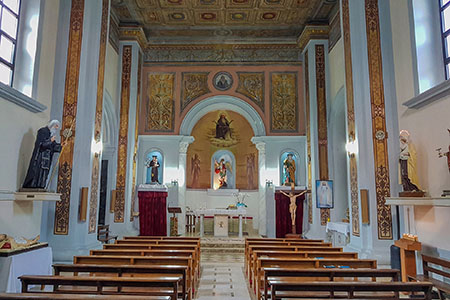
Saint Michael the Archangel
Internal view
Ancient, afflicted and praised.
The church of Saint Michael the Archangel, now located in the North side of Piazza San Nilo, was founded between 796 and 817 by the abbot Gisulfo together with the Monastery of Sant’Angelo, using the materials from the preceding Roman buildings of the Pagus Vallis Luci1. Between 948 and 985, the abbot Aligerno had the monastic complex restored to receive Saint Nilus the Younger2, who between 979 and 994 had it extended and adorned3. Between 1011 and 1022, Sant’Angelo became again a Benedictine dwelling and the abbot Atenolfo had it again extended and painted1-4. Once again in 1460, the church was enriched with a series of frescos of which only survived a Madonna with Child and other little fragments in the current sacristy. After the Sannio earthquake in 1688, the church obtained a new vault, new buttresses and baroque decorations. In the 1700s, the chapel of Saint Joseph was added to the church. In the second half of the 19th century, it was built the canonical house which caused a significant demolition of the three original apses and the building of the current apse. From the beginning of the 20th century, the church was subjected to a long series of changes, due to the World Wars and other seismic events which caused it to acquire the appearance we see today.
The church has a longitudinal plan. On the exterior it presents a simple white gabled facade, decorated with simple light grey cornices that follow its perimeter and ideally divide it into two registers. The portal is flanked by two Doric pilasters, which support a roman arch encasing a simple lunette. Underneath there’s a window with iron decorations on the inside. Above, there is a rose window which represents the statue of Saint Michael the Archangel, framed by two Doric columns with a lowered arch. On the right, placed slightly forward, there is the bell tower divided into four registers by four cornices. The central register presents on two sides two circular holes, containing an eight-pointed contoured star. The last register is longer than the other three, it has an aperture with a roman arch on each side and contains three bells.
The interior consists of a single apsed nave. It is currently decorated with numerous wall paintings with a stylized floral pattern made in 1955. They extend from the eight pillars of the nave to the ceiling painted with counterfeit ceiling coffers. The back wall has classical ornaments with candelabra, garlands and cherubs, in the center of which we find the clypeate image of God the Father and Eucharistic symbols. The apsidal arch is supported by two monolithic columns in granite with smooth shaft, with Corinthian capitals from the Roman times. The apsidal basin contains a vast painting where on top there is the Virgin praying with angels and below the Archangels Gabriel and Raphael. The main altar was built in 1975, thanks to Caterina Rossi after the demolition of the preceding Tridentine altar. At the end on the left side is the Chapel of Saint Joseph. Inside there is a magnificent neoclassical altar covered with marble, plaster and stucco that houses the 18th century papier-mâché statue of the saint. On the right side there’s the high altar of Our Lady of Sorrows, built in 1933 in memory of Benedetto and Maria Civita Di Cicco.
The statue of Saint Michael the Archangel is the most important sculptural work that is venerated in the church of Valleluce and certainly the most valuable. Its material and its craftsmanship in fact confirm without a doubt that it is a work of the Neapolitan workshops of wooden sculpture of the 18th-19th Century. It is 55,12 inches tall and is located in the niche of the apse, the visual center of the entire building. The Archangel Michael, who is represented with an elegant contrapposto, is caught in the moment of the victory on the Devil. His figure appears light and his gestures elegant and graceful, as if he had just landed after a flight. He’s wearing the paludamentum, the solemn uniform worn by Roman generals on the battlefield, according to his traditional iconography of the Roman Church. His uniform includes a feathered helmet, a pair of sandals and a red cloak on his left shoulder that flutters to his right. In his right hand he’s holding a thin sword while with his left hand points at the defeated Devil, who is portrayed as a canine looking beast.